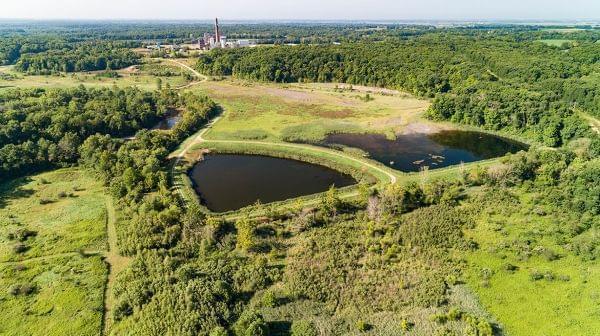Coal Ash Bill Passes House, Heads To Governor

Coal ash ponds at the Vermilion Power Plant, located in the floodplain of the Middle Fork of the Vermilion River. Darrell Hoemann/The Midwest Center for Investigative Reporting
Environmental groups are hailing passage of a bill (SB9) to regulate the cleanup of coal ash pits at Illinois power plant sites. The Illinois House passed the measure on Monday 77-35 with one member voting Present (following Senate passage on May 9), and it now goes to Governor Pritzker’s desk.
The bill’s sponsors were reacting to toxic coal ash (also known as coal combustion residual) seeping from storage ponds at the shuttered Dynegy Vermilion power plant near the Middle Fork of the Vermilion River.
But Andrew Rehn says the problem is widespread in Illinois. Rehn is a water resources engineer with the Prairie Rivers Network. The Champaign-based organization collaborated with other environmental groups on a report released last November examining data reported by 24 coal ash storage sites in Illinois. It concluded that 22 of the sites had reported unsafe levels of toxins in nearby groundwater last year.
“Boron is the most common,” said Rehn. “It’s everywhere. But it can also be things like arsenic or lead or chromium. And those are going into the groundwater. So we know that there’s an impact on many of these sites.”
SB9 would direct the Illinois EPA and Pollution Control Board to draw up rules for coal ash storage sites that match or exceed federal rules. Advocates say the state legislation will provide additional safeguards, public input and enforcement, above and beyond the federal regulations.
Rehn says the legislation would treat each site on a case-by-case basis --- including plans for their eventual closure, with utility companies paying the cost. Rehn says he hopes most closures would result in the coal ash waste being moved elsewhere.
“We recognize that this is a process that we have moving forward, which is the site-by-site analysis”, said Rehn. “And we think it will probably bear out that in many cases, removal is what’s appropriate to do. Because otherwise, the ash will remain in contact with groundwater.”
Rehn favors removing coal ash from on-site storage sites to ones located away from streams or aquifers that are vital to local water supplies. But he concedes that finding facilities in appropriate locations could be challenging.
SB9 was sponsored in the Illinois Senate by Senator Scott Bennett (D-Champaign), and in the House by Rep. Carol Ammons (D-Urbana). The Vermilion power plant site is located in Bennett’s Senate district, and in the House district of St. Rep. Mike Marron (R-Fithian), who was one of SB9’s Alternate Chief Co-Sponsors.
Ammons welcomed the House passage of the measure.
“Owners of coal plants have a responsibility to dutifully dispose of coal ash in order to prevent any sort of water contamination”, said Ammons in a news release. “This bill will help make that a reality.”
Sen. Bennett also hailed the bill’s House passage. A photo posted on his Facebook page shows the senator, Rep. Ammons and others who worked on the legislation posting with stress balls shaped like lumps of coal.
“I had these coal-shaped stress balls (appropriately) made to thank the vital members of #TeamCoalAsh,” wrote Bennett in his post. “The victory is a team effort.”
Rep. Marron praised the bipartisan support for the bill in a Facebook post.
“Coal ash and how we will deal with it is a major issue impacting my district because of the environmental hazards it poses to natural resource treasures like the Vermilion River across this State”, Marron wrote. “I need to keep the taxpayers of my district and the state of Illinois protected from potentially massive financial and environmental repercussions.”

